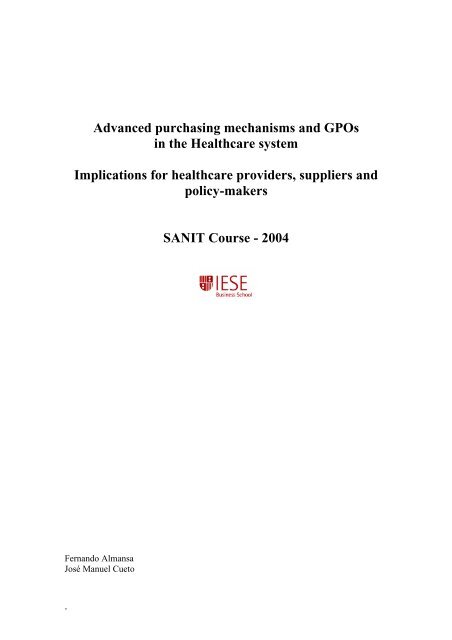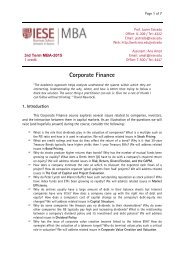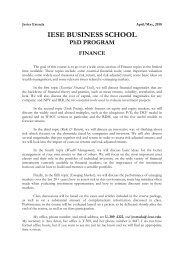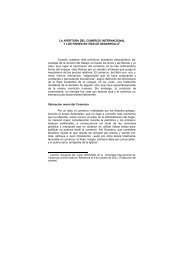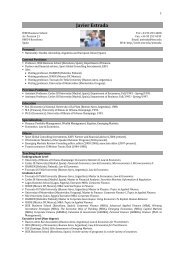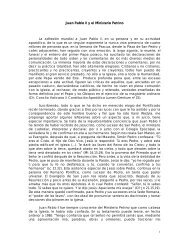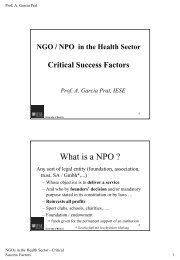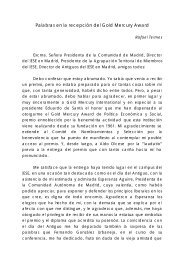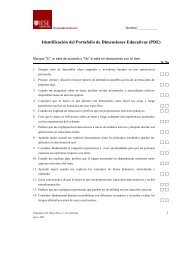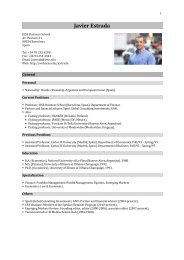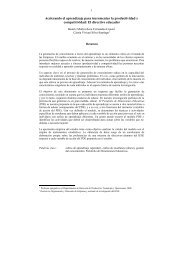GPOs and Advances Purchasing Mechanism - IESE Blog Community
GPOs and Advances Purchasing Mechanism - IESE Blog Community
GPOs and Advances Purchasing Mechanism - IESE Blog Community
Create successful ePaper yourself
Turn your PDF publications into a flip-book with our unique Google optimized e-Paper software.
Advanced purchasing mechanisms <strong>and</strong> <strong>GPOs</strong><br />
in the Healthcare system<br />
Implications for healthcare providers, suppliers <strong>and</strong><br />
policy-makers<br />
SANIT Course - 2004<br />
Fern<strong>and</strong>o Almansa<br />
José Manuel Cueto<br />
-
Table of contents.<br />
Table of contents........................................................................................................ 1<br />
Executive Summary.................................................................................................... 2<br />
Introduction ............................................................................................................... 3<br />
Introduction ............................................................................................................... 3<br />
Group <strong>Purchasing</strong>: typology <strong>and</strong> general characteristics. ....................................... 3<br />
International benchmark of <strong>GPOs</strong>............................................................................. 5<br />
<strong>GPOs</strong> in the US. ..................................................................................................... 5<br />
<strong>GPOs</strong> in Europe: France <strong>and</strong> UK. .......................................................................... 6<br />
<strong>GPOs</strong> in Spain ........................................................................................................ 7<br />
Implications for health-care providers, suppliers <strong>and</strong> policy-makers....................... 9<br />
Implications for health-care providers.................................................................... 9<br />
Implications for suppliers..................................................................................... 10<br />
Implications for policy-makers............................................................................. 11<br />
Conclusions.............................................................................................................. 12<br />
Links <strong>and</strong> Bibliography............................................................................................ 13<br />
-1-
Executive Summary<br />
<strong>GPOs</strong> are playing an important economic role in the different health-care systems in<br />
which they operate. Their major contribution is to help hospitals <strong>and</strong> other providers in<br />
reducing their supplies expenditures.<br />
Several models have been implemented to improve the purchasing mechanisms in<br />
Hospitals, which derive historically from public tenders <strong>and</strong> isolated purchasing by each<br />
hospital: unique supplier, unique catalogue (voluntary or compulsory) <strong>and</strong> unique<br />
catalogue plus logistics.<br />
In some cases, the unique catalogue model has been institutionalized through a group<br />
purchasing organization (GPO), an entity that helps health care providers-such as<br />
hospitals -realize savings by aggregating purchasing volume <strong>and</strong> using that leverage to<br />
negotiate discounts with manufacturers, distributors <strong>and</strong> other vendors. The future is in<br />
logistics management <strong>and</strong> in the Internet.<br />
GPO models have evolved differently depending on the country <strong>and</strong> the region<br />
considered.<br />
- The US has a very advanced model (with public <strong>and</strong> private initiatives competing in<br />
the market place), although the size of the <strong>GPOs</strong> (in some cases, national scope) has<br />
been contended.<br />
- In Europe, purchasing mechanisms have usually evolved inside the public<br />
healthcare system <strong>and</strong> are less developed than in the US. However, in recent times,<br />
big efforts have been made to keep on improving these systems.<br />
- In Spain, specifically, the Autonomias system has derived into 17 different<br />
purchasing systems (some more advanced than others). There should be incentives<br />
in place to share experiences <strong>and</strong> information from one region to another.<br />
These advanced purchasing mechanisms have implications for the different players in<br />
the Healthcare system:<br />
- Health-care providers. Apart from cost-savings that result from group purchasing,<br />
hospitals <strong>and</strong> other health care providers are increasingly relying on <strong>GPOs</strong> for<br />
sophisticated supply chain solutions to help manage <strong>and</strong> streamline the complex<br />
system of health care purchasing.<br />
- Suppliers. Several factors associated with group purchasing <strong>and</strong> public tenders lead<br />
to an increase in price competition for suppliers.<br />
- Policy-maker. <strong>GPOs</strong> could raise barriers to entry for potential small suppliers with a<br />
very good product offering. For these reason, it would be good for the industry as<br />
whole to set a minimum percentage of purchases to be made to small players<br />
(provided that they comply with quality <strong>and</strong> service requirements) <strong>and</strong>/or to foster<br />
non-compulsory models of GPO.<br />
-2-
Introduction<br />
<strong>GPOs</strong> are playing an important economic role in the different health-care systems in<br />
which they operate. Their major contribution is to help hospitals <strong>and</strong> other providers in<br />
reducing their supplies expenditures. In our <strong>GPOs</strong> analysis, we will review the Spanish<br />
health-care system, the US market, (currently, US hospitals channel approximately 72<br />
percent of non-labor expenditures through <strong>GPOs</strong>), <strong>and</strong> also that of Europe.<br />
Our motivation to choose this subject is to underst<strong>and</strong> the role <strong>GPOs</strong> play <strong>and</strong> their<br />
implications for the different actors of the health-care system: health-care providers,<br />
suppliers <strong>and</strong> policy-makers.<br />
Group <strong>Purchasing</strong>: typology <strong>and</strong> general characteristics.<br />
Graph 1 - Typology of advanced purchasing mechanisms<br />
1 2 3 4<br />
Unique supplier<br />
Unique<br />
catalogue<br />
(voluntary)<br />
Unique<br />
catalogue<br />
(compulsory)<br />
Unique<br />
catalogue +<br />
logistics<br />
Several models have been implemented to improve the purchasing mechanisms in<br />
Hospitals, which derive historically from public tenders <strong>and</strong> isolated purchasing by each<br />
hospital. The first of these models (implemented in the mid-nineties by Hospital Reina<br />
Sofía de Córdoba) is the unique supplier of several products model. The main<br />
characteristics of this model are the following:<br />
- Suppliers are usually against this model because it limits free competence in the<br />
sense that there would be only one supplier of several products, many of which<br />
would not be produced by this supplier (it would act as a mere intermediary).<br />
- The unique supplier may or may not be in charge of the management of the stocks.<br />
- Prices are known (purchases are done through a catalogue).<br />
- There is a unique speaker <strong>and</strong> a better control of the supply chain.<br />
- However, it conveys risk <strong>and</strong> service control to an outsourcer.<br />
The unique supplier model, but reduced to the supply management of one department or<br />
service area (e.g. Laboratories, Radiology, Kitchen), seems to give better results. Its<br />
main characteristics are the following:<br />
- There is resistance to implement this model, because professionals are used to<br />
contact several suppliers.<br />
- This model gives the possibility (sometimes obligation) for the supplier to introduce<br />
new technologies to guarantee the hospital’s service level agreements included in<br />
the contract.<br />
- If the contract is signed for a long period (3 to 4 years), hospitals can obtain bigger<br />
value from suppliers by homogenizing the information systems of all the<br />
laboratories of the hospital <strong>and</strong> forcing the supplier to make the necessary<br />
investment. In these situations, the supplier is usually building a huge barrier to exit.<br />
The unique catalogue model has been applied by the ICS since 1994 (also by Servei<br />
Valencia de Salut <strong>and</strong> Servicio Extremeño de Salud). The model can be either voluntary<br />
-3-
or compulsory for the participant hospitals. Each year, a catalogue is developed with<br />
unified criteria by purchasing officers <strong>and</strong> by professionals, reaching today to 6.000-<br />
7.000 products. There is a unique supplier per product in 82%-83% of items. The tender<br />
consists of two phases: first, each hospital provides its needs <strong>and</strong> a tender is issued as<br />
the sum of needs with a maximum price (only technically correct suppliers will make it<br />
to the second phase); second, the ICS centralizes the tender <strong>and</strong> negotiates<br />
consumptions <strong>and</strong> prices with the suppliers. During the first years of the implementation,<br />
little hospitals were the most favoured by the system. Some of the main characteristics<br />
of this model are the following:<br />
- If more representativity is given to the users that consume the product the most, they<br />
will choose their usual supplier.<br />
- Professionals spend time evaluating products, not in their professional activity.<br />
- Some professionals do not consult the catalogue.<br />
- Another problem is the amount of time spent by professionals from different<br />
hospitals to decide what products are selected. This last problem will be solved in<br />
the future by creating a register system whereby for each product you have all the<br />
references from the product as of today available in the market, the supplier<br />
reference <strong>and</strong> its technical note. This new methodology makes sense for products<br />
with low differentiation relative to high-technological products.<br />
In some cases, this unique catalogue model has been institutionalized through a group<br />
purchasing organization (GPO), an entity that helps health care providers-such as<br />
hospitals -realize savings by aggregating purchasing volume <strong>and</strong> using that leverage to<br />
negotiate discounts with manufacturers, distributors <strong>and</strong> other vendors. In a more<br />
general sense, <strong>GPOs</strong> provide three essential functions for health care providers:<br />
- Aggregate buying power in order to obtain discounts from manufacturers <strong>and</strong><br />
distributors (strategic alliance, pool purchasing dollars to exert leverage over<br />
suppliers, concrete avenue for economies of scale, lower unit costs for members,<br />
negotiate & manage contracts).<br />
- Facilitate <strong>and</strong> enhance comprehensive product comparison analysis, using clinician<br />
input (update pricing changes, disseminate information from vendors under contract,<br />
cost reduction tools for members, benchmarking data).<br />
- Finally, they streamline <strong>and</strong> st<strong>and</strong>ardize the purchasing process, thereby reducing<br />
the inefficiencies inherent in today’s health care systems <strong>and</strong> offering valuable cost<br />
avoidance savings to providers (product st<strong>and</strong>ardization programs, product<br />
utilization programs, designate authorized distribution agents (ADAs), private label<br />
programs for smaller manufacturers).<br />
In the future, the next step for <strong>GPOs</strong> would be to assume the logistic function of the<br />
hospitals it serves <strong>and</strong> to exp<strong>and</strong> its services through Internet.<br />
-4-
International benchmark of <strong>GPOs</strong>.<br />
<strong>GPOs</strong> in the US.<br />
Although provider group purchasing has existed since 1909 in the US, it was not until<br />
the 1970s <strong>and</strong> 1980s that national <strong>GPOs</strong> emerged, through the mergers of state <strong>and</strong> local<br />
<strong>GPOs</strong>. Severe financial pressures for health care providers increased dem<strong>and</strong> for tools<br />
to reduce operational expense, such as <strong>GPOs</strong> (one third of US community hospitals had<br />
negative margins in 2000, 60% had negative Medicare, nearly two-thirds lost money on<br />
patient). By 2002, group purchasing sales volume was higher than ever, with the seven<br />
largest national <strong>GPOs</strong> maintaining contract portfolios representing purchases of nearly<br />
$43 billion annually.<br />
Graph 2 – <strong>GPOs</strong> in the US<br />
Source: HPN survey<br />
The GPO industry in the US is large <strong>and</strong> concentrated. There are 600-700 <strong>GPOs</strong> in<br />
healthcare industry; however, 7 national <strong>GPOs</strong> account for more than 85% of all<br />
hospital purchases nationwide made through GPO contracts. There are differences in<br />
terms of ownership (for-profit, nonprofit, public), geography covered <strong>and</strong> membership<br />
(hospital vs. alternate site market). Up to 98% of hospitals nationally participate in<br />
GPO’s. On average, hospitals utilize the services of at least two, <strong>and</strong> as many as four,<br />
<strong>GPOs</strong> per facility, according to a report by SMG Marketing.<br />
The two largest <strong>GPOs</strong> account for about 66% of total GPO purchasing volume for all<br />
medical products (including, among other things, medical-surgical products,<br />
pharmaceuticals, capital equipment, <strong>and</strong> food). These two <strong>GPOs</strong> also account for 70 %<br />
of the seven <strong>GPOs</strong>’ total medical-surgical product volume. One of the two largest <strong>GPOs</strong><br />
has as members 1,517 of the nation’s approximately 6,900 hospitals; the other has 1,469<br />
hospital members. One of the two largest <strong>GPOs</strong> permits its members to belong to other<br />
national <strong>GPOs</strong>, whereas the other largest GPO does not.<br />
Vendors pay <strong>GPOs</strong> administrative fees based on sales. Those fees finance operations,<br />
while surplus fees are distributed to owners or used to finance new ventures. <strong>GPOs</strong><br />
argue that seller-based fees <strong>and</strong> buying cooperatives are widely accepted competitive<br />
business models in many industries (agriculture, real estate, insurance).<br />
<strong>GPOs</strong> save hospitals <strong>and</strong> free st<strong>and</strong>ing nursing homes between 10 to 15 percent of their<br />
purchasing costs in the US. However, the practices of <strong>GPOs</strong> have been criticized <strong>and</strong><br />
some industry analysts are seriously questioning the future of group purchasing:<br />
-5-
- Suppliers resent the ability of large <strong>GPOs</strong> to drive down the margins that the<br />
suppliers had enjoyed in years past, as well as the high administrative fees <strong>GPOs</strong><br />
charge suppliers to fund their contracting services.<br />
- Providers also have become dissatisfied with <strong>GPOs</strong>, which have instigated high<br />
membership dues <strong>and</strong> required members to commit to purchasing a significant<br />
percentage of their supplies using GPO-negotiated contracts.<br />
- The contracts that <strong>GPOs</strong> negotiate with large, multi-product suppliers have the<br />
effect of blocking the introduction of highly cost-effective products to healthcare<br />
organizations.<br />
- Although suppliers clearly are interested in negotiating the enormous contracts that<br />
are possible with <strong>GPOs</strong>, they also are looking for practical alternatives to dealing<br />
with these sometimes unwieldy organizations, including opportunities to contract<br />
directly with regional hospital alliances <strong>and</strong> purchasing co-ops.<br />
- The sheer size of today's national <strong>GPOs</strong> also poses a serious problem for these<br />
organizations. Getting 500, 1.000, or even 1.500 hospitals to move in a common<br />
direction is difficult, if not impossible.<br />
<strong>GPOs</strong> in Europe: France <strong>and</strong> UK.<br />
France.<br />
The French medical market is tightly regulated by the Health Ministry. Both public <strong>and</strong><br />
private hospitals require authorisation prior to purchasing expensive high-technology<br />
equipment. In November 2001, the regional hospital agencies were made responsible<br />
for authorising most types of high-technology equipment, whilst equipment requiring<br />
authorisation at ministerial level was limited to open-heart surgery equipment, medical<br />
cyclotrons, <strong>and</strong> PET scanners. The government is now proposing to make the regional<br />
hospital agencies responsible for all high-technology equipment authorisations.<br />
Decisions will be taken on the basis of local population need <strong>and</strong> will no longer have to<br />
comply with arbitrary national limits on equipment numbers. It is hoped that<br />
decentralising the decision-making process to regional level will speed up the<br />
authorisation process, which normally takes several years.<br />
Procurement by tender is the norm for public hospitals. Tenders are issued by the<br />
hospital boards <strong>and</strong> individual hospitals. In the past, smaller hospitals have often used a<br />
purchasing organisation known as Union des Groupements d'Achat Publique (UGAP).<br />
However, this organisation has recently been in financial difficulties prompting a major<br />
restructuring programme <strong>and</strong> an overhaul of its procurement procedures, <strong>and</strong> it is likely<br />
that fewer hospitals will purchase through UGAP in the future.<br />
The Hospital 2007 reform programme includes proposals to overhaul public hospital<br />
purchasing procedures. The aim is to focus more closely on securing value for money as<br />
opposed to merely ensuring that purchasing procedures are in line with the current code<br />
of practice (equal access to public sector contracts, competitive bidding, transparency of<br />
procedures <strong>and</strong> decision-making). The move is in part a response to government<br />
findings that in some cases public hospitals are paying up to 20% more for costly drugs.<br />
Private procurement is less structured. Most private hospitals buy direct or through a<br />
purchasing body. The leading private hospital operator, Générale de Santé, which has<br />
-6-
annual purchases of some 275 million euros, has announced the establishment of a<br />
central purchasing unit designed to achieve economies of 10% within three years.<br />
UK.<br />
In the public sector, NHS trusts have primary responsibility for medical equipment<br />
management, including purchasing <strong>and</strong> maintenance. Trusts receive funding for<br />
equipment from the NHS Executive <strong>and</strong> are accountable for their expenditure.<br />
<strong>Purchasing</strong> procedures differ between trusts but procurement is generally either through<br />
the NHS <strong>Purchasing</strong> <strong>and</strong> Supply Authority, or put out to tender direct to suppliers <strong>and</strong><br />
manufacturers.<br />
In April 2000, the NHS <strong>Purchasing</strong> <strong>and</strong> Supply Agency was established as an executive<br />
agency, replacing the purchasing <strong>and</strong> strategy divisions of the NHS Supplies Authority.<br />
The NHS <strong>Purchasing</strong> <strong>and</strong> Supply Agency has recently formed a partnership with NICE<br />
(National Institute for Clinical Excellence) to provide NHS trusts with a central<br />
database of information on the performance of artificial hip joints. The agency has also<br />
worked on a number of projects in conjunction with the MDA (Medical Devices<br />
Agency) <strong>and</strong> the ABHI (Association of British Healthcare Industries).<br />
Since 2001, the NHS <strong>Purchasing</strong> <strong>and</strong> Supply Agency has been assisting with the<br />
implementation of the NHS Plan. As part of the programme, the agency is already<br />
linked into a number of key priorities identified in the NHS plan <strong>and</strong> has made<br />
significant contributions including the procurement of IT systems <strong>and</strong> associated<br />
equipment, the purchase of specialist medical equipment for cancer treatment <strong>and</strong> the<br />
supply of single use instruments for tonsil surgery. With regard to the NHS plan, the<br />
<strong>Purchasing</strong> <strong>and</strong> Supply Agency has also continued to work closely with NICE to ensure<br />
that their appraisals <strong>and</strong> recommended guidelines are implemented.<br />
<strong>GPOs</strong> in Spain<br />
Evolution <strong>and</strong> background<br />
In the past, public sector purchases under US$100,000 in value were generally h<strong>and</strong>led<br />
by hospital administrators without recourse to tendering. Each hospital managed its own<br />
budget independently without considering potential economies of scale from belonging<br />
to a group of hospitals.<br />
Later on, the government published a new tenders law which stipulated that all public<br />
purchases of medical equipment valued at more than Ptas. 2 million (US$16,000) had to<br />
be made by invitations to tender published in the official government journal, the<br />
Boletín Oficial del Estado, <strong>and</strong> two high-circulation national newspapers. Tenders for<br />
contracts valued at more than Ptas. 102.25 million (US$815,000) had also to be<br />
published in the EU Official Journal. In order to bid for tenders, foreign companies<br />
must have a Spanish subsidiary or appoint a recognised representative.<br />
At the same time, there were moves to give hospitals greater autonomy in the field of<br />
purchasing. A number of medical technology evaluation agencies were set up. The first<br />
agency of this type was the Agencia d’Avaluacio de Tecnologia Medica (AATM) set up<br />
in Barcelona in 1991. The AATM is a non-profitmaking public company partly funded<br />
-7-
y the Catalonian Health Service, which carries out assessment surveys for hospitals,<br />
health insurers <strong>and</strong> the medical industry.<br />
In the mid-nineties, there was a revolution in the way hospitals manage their purchases.<br />
We saw innovation in logistics, greater education, centralized catalogues, group<br />
purchasing. The first model of advanced purchasing, unique supplier of several products,<br />
was implemented by Hospital Reina Sofía de Córdoba. The unique catalogue model was<br />
applied by the ICS since 1994 (also by Servei Valencia de Salut <strong>and</strong> Servicio<br />
Extremeño de Salud).<br />
Nowadays, we have to differentiate those regions which have been managing their<br />
competencies for a long time from those that have just started in 2002. Obviously, we<br />
find that the former regions have much more advanced models of group purchasing<br />
organizations. Here, there should be incentives in place to share experiences <strong>and</strong><br />
information from one region to another. In all, there will be 17 separate purchasing<br />
systems.<br />
The typical purchasing model today is to have a unique catalogue for the needs of<br />
health-care providers of a region. A tender by product type is then organized on a yearly<br />
basis. This is the case for many regions such as Cataluña, Comunidad Valenciana <strong>and</strong><br />
Andalucía.<br />
In the future, we could envisage a system where regions share their catalogues, so that<br />
one region with a dominant position in one product line could translate the benefits to<br />
other regions. Alternatively, when a hospital needs a certain product, they call the<br />
supplier that won the tender for that product <strong>and</strong> ask for the product delivery. This<br />
process could be centralized in the future saving some transaction costs. This model<br />
could make sense for small hospitals because of their lack of scale.<br />
Example 1 of GPO: Banco de Productos del SAS<br />
The Servicio Andaluz de Salud (SAS) is the public organisation for the Andalucia<br />
region responsible for providing health-care services to citizens from the region.<br />
The SAS has recently centralized all the purchasing process of products <strong>and</strong> materials<br />
from public health-care institutions. Basically, the products <strong>and</strong> materials that can be<br />
used by hospitals must first be screened <strong>and</strong> registered into a centralized database. Then,<br />
the SAS opens public tenders to secure the supply of specific products or materials.<br />
Once the public tender has been allocated to a supplier, the payment, stocking <strong>and</strong><br />
distribution of the products are managed on a centralized basis.<br />
This group purchasing initiative seeks reducing purchasing costs for products <strong>and</strong><br />
materials, as well as improving efficiencies in supply <strong>and</strong> logistics management.<br />
Example 2 of GPO: Saniline<br />
Saniline is the leading company in Spain offering services of supply chain management<br />
activities for health-care providers <strong>and</strong> suppliers through its Internet platform. Saniline<br />
believes that connecting clients <strong>and</strong> suppliers through the Internet is a powerful<br />
efficiency driver of supply chain processes as well as a cost reduction tool.<br />
-8-
Saniline is offering to its clients the following lists of services:<br />
- Refined <strong>and</strong> actualized products catalogue connected with suppliers.<br />
- Offers, orders, invoices in electronic format.<br />
- Integration of Information systems within the hospital, connectivity <strong>and</strong><br />
automatization of processes with suppliers.<br />
- Management reports <strong>and</strong> benchmarking.<br />
- Communication of public tenders to potential suppliers.<br />
One of the success story from Saniline has been the project for “Servicio Extremeño de<br />
Salud (SES)” done in 2002. The objective was to create a unique catalogue for a group<br />
of eight hospitals.<br />
Today, the unique catalogue <strong>and</strong> its platform enable the eight hospitals <strong>and</strong> the SES to<br />
speak a common language in supply management. This means having precise statistics,<br />
homogeneous information <strong>and</strong> better budgeting control.<br />
Implications for health-care providers, suppliers <strong>and</strong> policy-makers<br />
Implications for health-care providers<br />
As an industry, <strong>GPOs</strong> save providers between 10 to 15 percent of what they would pay<br />
without the benefit of a GPO. Even when providers purchase directly from suppliers,<br />
they benefit from the GPO contracting process because suppliers have to price direct<br />
purchases to compete with annual GPO contracts. In an era when many hospitals have<br />
negative operating margins, reimbursements from private <strong>and</strong> public payers are falling,<br />
<strong>and</strong> overall expenditures are rising, this substantial cost saving is of critical importance.<br />
However, <strong>GPOs</strong> do not always get better prices <strong>and</strong> these savings depend on the size of<br />
the hospital (the smaller the hospital, the bigger the savings).<br />
In addition to being able to get discounts in return for aggregating volume purchases,<br />
<strong>GPOs</strong> also reduce providers' administrative overhead costs, <strong>and</strong> offer supply chain<br />
efficiencies for health care providers in the procurement, st<strong>and</strong>ardization, <strong>and</strong><br />
contracting functions. This concept includes the volume discounts <strong>GPOs</strong> provide <strong>and</strong><br />
also the benefits that result from taking out of the hospital much of the work that goes<br />
into identifying, tracking <strong>and</strong> performing due diligence on suppliers as well as<br />
negotiating, maintaining <strong>and</strong> updating contracts.<br />
Apart from cost-savings that result from group purchasing, hospitals <strong>and</strong> other health<br />
care providers are increasingly relying on <strong>GPOs</strong> for sophisticated supply chain solutions<br />
to help manage <strong>and</strong> streamline the complex system of health care purchasing. Many<br />
<strong>GPOs</strong> offer providers e-commerce solutions that reduce widely recognized<br />
inefficiencies in the health care supply chain. The GPO community is also a leader in<br />
the effort to reduce medical errors, through such efforts as st<strong>and</strong>ardizing product use<br />
within a facility to reduce unnecessary variation, educating clinicians on best practices,<br />
<strong>and</strong> leading the drive to institute bar coding for medical products.<br />
-9-
Fundamentally, <strong>GPOs</strong> are able to offer additional value to their provider-members<br />
because much of their operating revenue is generated through earning administrative<br />
fees paid by suppliers (at least in the US). It has been recognised that there is value in<br />
allowing such fees, given that the alternative would be for hospitals to take money away<br />
from patient care. However, some manufacturers have claimed that allowing <strong>GPOs</strong> to<br />
earn administrative fees creates a conflict of interest for <strong>GPOs</strong> <strong>and</strong> reduces their<br />
responsiveness to their provider members.<br />
<strong>GPOs</strong> play a critical role in drawing upon <strong>and</strong> consolidating the clinical expertise of<br />
hospitals. What researchers have found is that, in working with <strong>GPOs</strong>, hospitals seek to<br />
make clinically informed, evidence-based decisions about which medical products will<br />
offer the highest quality of care to patients.<br />
Another claim heard from some manufacturers is that specific contract structures create<br />
a situation where the best products are not available to providers. However, at the end of<br />
the day, it is up to individual providers whether to purchase products via a GPO contract,<br />
or whether to make purchases independent of a GPO. Additionally, in the long run,<br />
<strong>GPOs</strong> could create a monopoly or raise barriers to entry of new suppliers, indirectly<br />
rising prices.<br />
Implications for suppliers<br />
Group purchasing has several significant implications for suppliers:<br />
1. Increasing competitive pressure.<br />
Several factors associated with group purchasing <strong>and</strong> public tenders lead to an increase<br />
in price competition for suppliers. First, group purchasing implies buying more<br />
quantities of product, naturally leading to lower prices.<br />
Second, when group purchases are done through a public tender process, suppliers<br />
compete at the same time for a specific contract which pressures them to lower the price<br />
to beat their respective competitors.<br />
Third, sometimes group purchasing is done on a long-term basis meaning that the<br />
contract implies securing the supplies of a certain product for months <strong>and</strong> sometimes<br />
years. This increases even more the size of the purchase, which leads to greater price<br />
competition. For example, the public health-care organisation for Comunidad<br />
Valenciana (SERVASA) opened a public tender to buy a specific medical device for all<br />
the public hospitals of the region for the next three years. Say you are one of the<br />
suppliers <strong>and</strong> that you lose the tender. This would imply not being able to sell any<br />
volume of this medical device for three years in this region. Again, long-term group<br />
purchases pressure prices downwards.<br />
Finally, group purchasing means more transparency in prices, leading to lower ability<br />
for suppliers to do price discrimination between hospitals. Given the enormous quantity<br />
of product references consumed by a hospital, suppliers manage to sell a specific<br />
product at a much higher price to some clients than to others. When both clients do their<br />
purchases of products together, they will have more price transparency on the product<br />
ending up paying the lowest of the two prices.<br />
-10-
2. Focus the organisation towards selling to <strong>GPOs</strong><br />
If hospitals start to centralise purchases through a group purchasing organisation,<br />
suppliers need to build, maintain <strong>and</strong> sustain a business relationship with the new<br />
organisation. In the case of the “Banco de Productos del SAS”, the first step a supplier<br />
would need to do to sell any of his products to any hospital is to register the product into<br />
the centralized database.<br />
Sales people need also to take care of the group purchasing organisations in order to<br />
influence the buying decision. This often implies educating the decision makers about<br />
the special benefits <strong>and</strong> characteristics of the product (non-financial factors).<br />
3. Size <strong>and</strong> breadth matters<br />
We know that public tenders are awarded based on a price factor but also on a quality<br />
<strong>and</strong> a service factor. For this, it will be crucial to have the right scale to offer<br />
competitive prices as well as to have the latest technology in your product <strong>and</strong> the<br />
capabilities to offer a good service to the client.<br />
Implications for policy-makers<br />
It is evident that <strong>GPOs</strong> generate savings for the system as a whole; however, it should<br />
be taken into account that pricing issues may drive (solely) <strong>GPOs</strong> performance leaving<br />
aside other relevant criteria for supplier selection such as quality <strong>and</strong> service. On this<br />
issue, policy-makers should foster the creation of a code of conduct for <strong>GPOs</strong> with the<br />
purpose of strengthening <strong>and</strong> improving the delivery of products <strong>and</strong> services to health<br />
care providers.<br />
These codes of conducts should focus on several issues: eliminating the potential for<br />
conflicts of interests; ensuring open communications between members <strong>and</strong> vendors;<br />
establishing guidelines for the use of contracting tools <strong>and</strong>, establishing reporting <strong>and</strong><br />
educating programs, including surveys to quantify the value of <strong>GPOs</strong>.<br />
Perhaps, a regulatory body should be created to supervise the performance of <strong>GPOs</strong> <strong>and</strong><br />
specifically issue regulations <strong>and</strong> st<strong>and</strong>ards. This organism should, for example,<br />
supervise that the GPO does not become too big which could cause rigidities <strong>and</strong><br />
inefficiencies in the buying process.<br />
Additionally, <strong>GPOs</strong> could raise barriers to entry for potential small suppliers with a very<br />
good product offering. For these reason, it would be good for the industry as whole to<br />
set a minimum percentage of purchases to be made to small players (provided that they<br />
comply with quality <strong>and</strong> service requirements) <strong>and</strong>/or to foster non-compulsory models<br />
of GPO.<br />
-11-
Conclusions<br />
- Due to high pressures on health-care cost reduction, Hospitals have developed<br />
several initiatives to reduce their purchasing budgets. <strong>GPOs</strong> have arisen as a<br />
solution for Hospitals, concentrating in the following issues:<br />
• Aggregate buying power in order to obtain discounts from manufacturers <strong>and</strong><br />
distributors.<br />
• Facilitate <strong>and</strong> enhance comprehensive product comparison analysis, using<br />
clinician input.<br />
• Finally, they streamline <strong>and</strong> st<strong>and</strong>ardize the purchasing process, thereby<br />
reducing the inefficiencies inherent in today’s health care systems <strong>and</strong><br />
offering valuable cost avoidance savings to providers<br />
- In the future, GPO models will create efficiencies in logistics <strong>and</strong> will use the<br />
internet in their advantage.<br />
- GPO models have evolved differently depending on the country <strong>and</strong> the region<br />
considered.<br />
• The US has a very advanced model (with public <strong>and</strong> private initiatives<br />
competing in the market place), although the size of the <strong>GPOs</strong> (in some cases,<br />
national scope) has been contended for several reasons (drive down the<br />
margins; members required to commit to purchasing a significant percentage<br />
of their supplies using GPO-negotiated contracts; block the introduction of<br />
highly cost-effective products to healthcare organizations; getting 1.500<br />
hospitals to move in a common direction is difficult, if not impossible).<br />
• In Europe, purchasing mechanisms have usually evolved inside the public<br />
healthcare system <strong>and</strong> are less developed than in the US. However, in recent<br />
times, big efforts have been made to keep on improving these systems.<br />
• In Spain, specifically, the Autonomias system has derived into 17 different<br />
purchasing systems (some more advanced than others). There should be<br />
incentives in place to share experiences <strong>and</strong> information from one region to<br />
another.<br />
- In the risk side, regulators should keep an eye on the possibility of too much<br />
concentration (both in the Pharma industry –too long contracts could derive in<br />
monopolies- <strong>and</strong> in the GPO industry), which could be detrimental for the system in<br />
general.<br />
- Policy-makers should foster the creation of a code of conduct for <strong>GPOs</strong> with the<br />
purpose of strengthening <strong>and</strong> improving the delivery of products <strong>and</strong> services to<br />
health care providers <strong>and</strong> to avoid an excessive focus on the price criterion.<br />
-12-
Links <strong>and</strong> Bibliography<br />
- Online healthcare purchasing. Sganga, John P. Healthcare Executive, Sept./Oct.<br />
2001.<br />
- Evaluating <strong>GPOs</strong>. Kaldor, Dennis C. et al. Healthcare Financial Management,<br />
January 2003.<br />
- Testing the GPO waters. Dula, Martha A. Healthcare Financial Management, June<br />
2004.<br />
- Group <strong>Purchasing</strong> Organizations: use of contracting processes <strong>and</strong> strategies to<br />
award contracts for medical-surgical products. United States General Accounting<br />
Office. July 2003.<br />
- Spain. Medistat world medical market analysis. July 2004.<br />
- ¿La compra corporativa limita la autonomía de los centros? Plataformas de compras.<br />
Bou, J. Fundación Signo. January 2003.<br />
- El Proyecto de Gestión de Compras en el Servei Balear de Salut. Palomino Chacón,<br />
M, Toll-Messía Gil, F. Gestión y Evaluación de Costes Sanitarios. Fundación Signo.<br />
Oct./Dec. 2002.<br />
- Saniline. www.saniline.com.<br />
- Federal Trade Commission's Health Care <strong>and</strong> Competition Law <strong>and</strong> Policy<br />
Workshop. http://www.ftc.gov/ogc/healthcare/agenda.htm.<br />
- Health Industry Group <strong>Purchasing</strong> Association. http://www.higpa.org/.<br />
Barcelona, December 8 th 2004.<br />
-13-


